
- •Preface
- •Content
- •Tissues
- •Nerve Tissue
- •Skin - Epidermis
- •Skin - Dermis
- •Skin - Glands
- •Subcutaneous Layer
- •Skeleton
- •Axial Skeleton
- •Cranium
- •Cranial Bones – Inferior Nasal Concha
- •Vertebral Column
- •Sacrum and Coccyx
- •Ribs
- •Sternum
- •Clavicle
- •Scapula
- •Humerus
- •Ulna
- •Radius
- •Metacarpals and Phalanges
- •Pelvis - Male
- •Femur
- •Tibia
- •Fibula
- •Tarsal Bones - Cuboid and Navicular
- •Phalanges
- •Patella
- •Skeletal Muscles
- •Transversospinales Muscles
- •Cervical Hypaxial Muscles
- •Thoracic and Abdominal Hypaxial Muscles
- •Shoulder Muscles - Rotator Cuff
- •Shoulder Muscles - Prime Movers
- •Anterior Brachial Muscles
- •Posterior Brachial Muscles
- •Posterior Thigh Muscles
- •Thigh Muscles
- •Lateral Leg Muscles
- •Posterior Leg Muscles
- •Spinal Nerves
- •Dorsal Rami
- •Intercostal Nerves
- •Cutaneous Nerves
- •Autonomic Nerves
- •Spinal Cord
- •Brain
- •Cerebrum
- •Cerebellum
- •Meninges
- •Hypothalamus
- •Pituitary Gland
- •Pineal Gland
- •Thymus
- •Pancreas
- •Ovaries
- •Testes
- •Blood
- •Heart
- •Lymphatics
- •Larynx
- •Lungs
- •Cast of Trachea and Bronchial Tree
- •Esophagus
- •Stomach
- •Pancreas
- •Large Intestine
- •Mesenteries
- •Omenta
- •Female Reproductive Organs
- •Ovary
- •Vagina
- •Ductus Deferens and Spermatic Cord
- •Penis
- •Index

Cerebrum The cerebrum, by far the largest part of the human brain, consists of the cerebral hemispheres and the basal nuclei. The large, obvious cerebrum is divided into two halves, the right and left
cerebral hemispheres. Each cerebral hemisphere has an outer layer of gray matter, the cerebral cortex, covering deeper networks of interconnecting white tracts that connect different areas of the cortex with one another and with lower brain centers. The amount of cortex is greatly increased by a complex folding of the cerebral surface. The folds produce hills, gyri (singular gyrus), and depressions, sulci (singular sulcus). This cortical surface forms the highest level of processing circuitry in the brain. The two hemispheres are connected to each other by the corpus callosum, a thick band consisting of an estimated 300 million neuronal axons traversing between the two hemispheres. Located deep within the cerebrum is another region of gray matter, the basal nuclei, which form key integration centers between the cortex and lower brain centers.
1 |
Central sulcus |
8 |
Calcarine sulcus |
15 |
Short gyri |
2 |
Precentral gyrus |
9 |
Superior temporal gyrus |
16 |
Long gyrus |
3 |
Postcentral gyrus |
10 |
Middle temporal gyrus |
17 |
Limen |
4 |
Precentral sulcus |
11 |
Inferior temporal gyrus |
18 |
Pons |
5 |
Postcentral sulcus |
12 |
Inferior frontal gyrus |
19 |
Cerebellum |
6 |
Parieto-occipital sulcus |
13 |
Middle frontal gyrus |
20 |
Medulla oblongata |
7 |
Transverse occipital sulcus |
14 |
Superior frontal gyrus |
21 |
Spinal cord |
|
|
14 |
5 |
1 |
4 |
|
||
|
|
32
13
|
12 |
6 |
|
16 |
15 |
7 |
15 |
|
16 |
||
|
||
|
12 |
|
|
17 |
|
|
9 |
|
8 |
10 |
|
|
||
|
11 |
|
|
18 |
|
|
19 |
|
|
20 |
21
Brain dissection revealing insular lobe
Lateral view
238
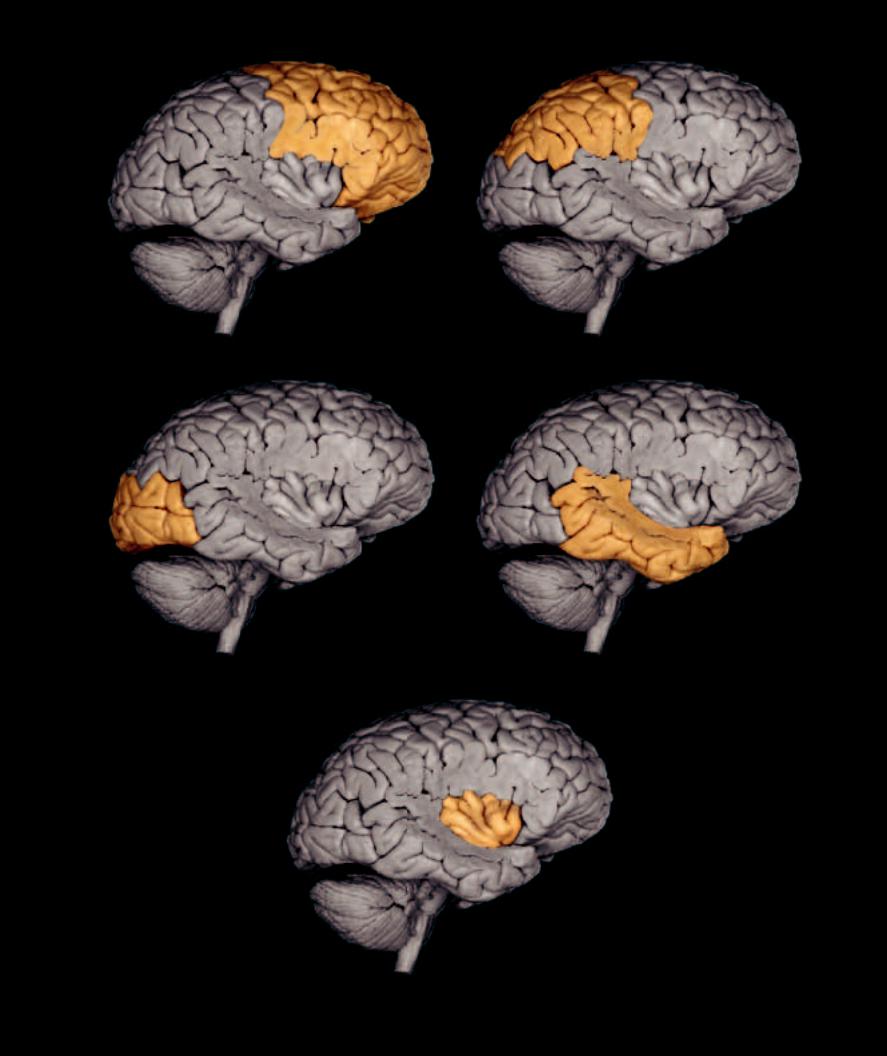
Frontal lobe |
Parietal lobe |
Occipital lobe |
Temporal lobe |
Insular lobe
239

Cerebellum Immediately above the medulla oblongata the central nervous system expands dorsally to form the cerebellum, which means little brain. The cerebellum, like the cerebrum, has
a highly folded surface that greatly increases the surface area of its outer gray matter cortex. It is estimated that the cerebellum has in the neighborhood of 10 billion neurons, which have a variety of functional roles. The cerebellum processes input received from the cerebral cortex, various brain stem nuclei, and peripheral sensory receptors to smooth and coordinate complex, skilled movements. It plays an important role in posture and balance and functions in cognition and language processing.
1 |
Folia of cerebellum |
10 |
Primary fissure |
19 |
Uvula |
2 |
Anterior lobe of cerebellum |
11 |
Flocculus |
20 |
Nodulus |
3 |
Posterior lobe of cerebellum |
12 |
Lingula |
21 |
Midbrain |
4 |
Superior vermis |
13 |
Central lobule |
22 |
Superior medullary velum |
5 |
Inferior vermis |
14 |
Culmen |
23 |
Fourth ventricle |
6 |
Postlunate fissure |
15 |
Declive |
24 |
Median aperture |
7 |
Posterior cerebellar notch |
16 |
Folium |
25 |
Cerebral aqueduct |
8 |
Tonsil |
17 |
Tuber |
26 |
Pons |
9 |
Quadrangular lobe of anterior |
18 |
Pyramid |
27 |
Medulla oblongata |
|
|
|
4 |
|
|
2
7
6
3
5
8
Cerebellum
Posterior view
|
|
|
|
|
|
|
|
14 |
|
|
|
|
|
|
|
|
|
|
|
|
|
|
25 |
|
|||
|
|
|
|
|
|
|
15 |
|
|
|
|
|
|
|
|
|
|
|
|
|
13 |
|
|
||||
|
|
|
|
|
|
|
|
|
|
||||
|
|
|
|
|
|
|
16 |
21 |
|||||
10 |
|
|
17 |
12 |
|
22 |
|||||||
|
9 |
|
|
|
|
|
|||||||
|
|
|
|
|
|
|
|
|
|
||||
|
|
|
|
|
|
|
|
|
|
|
|
|
|
|
|
|
|
|
|
|
18 |
23 |
|
|
|
||
2 |
|
26 |
|||||||||||
6 |
|
|
|
|
|
|
11 |
||||||
|
|
|
|
|
|
||||||||
|
|
|
|
3 |
|
19 |
|
|
|
24 |
|
||
|
|
|
|
|
|
|
|
||||||
|
|
|
|
|
|
|
|||||||
1 |
|
|
|
|
20 |
|
|
|
|
|
|||
|
|
|
|
|
|
|
|
|
|||||
|
|
|
|
|
|
|
|
|
|
|
|||
|
|
|
|
|
|
27 |
|
|
|
||||
|
|
|
|
|
|
|
8 |
|
|
|
|
|
|
Cerebellum |
Sagittal section of cerebellum |
Lateral view |
Medial view |
240
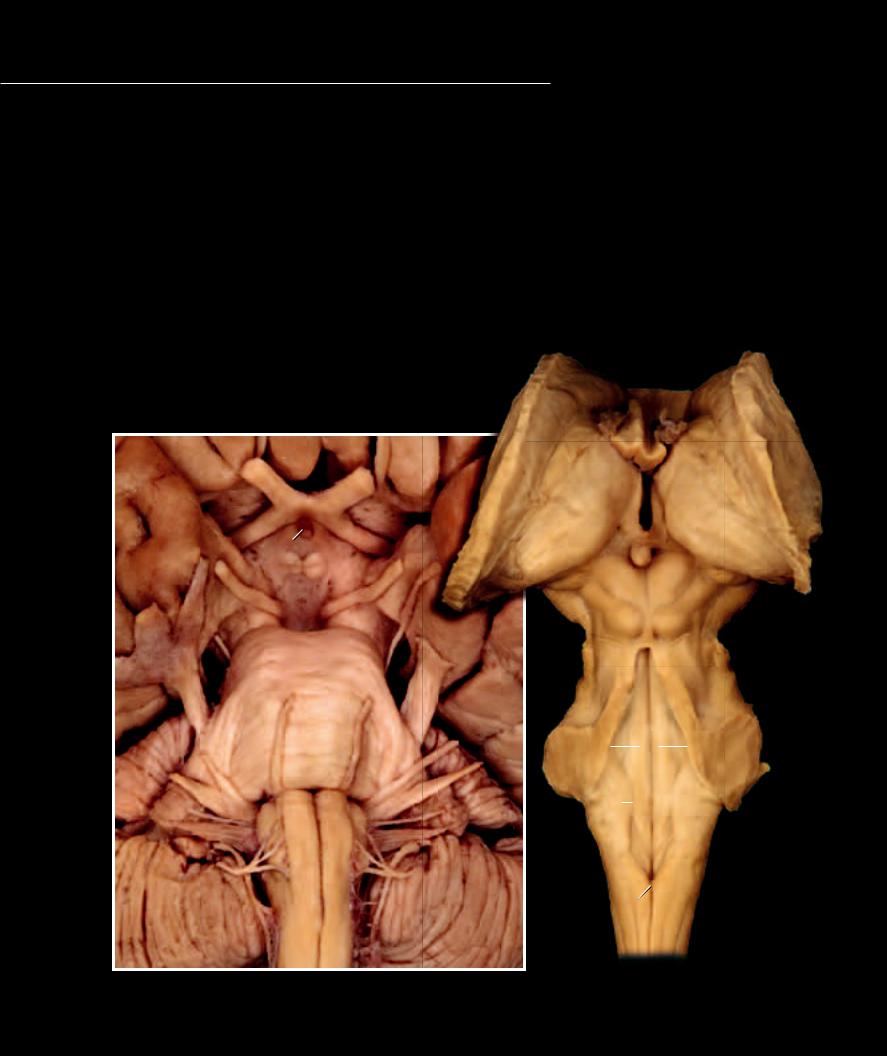
The diencephalon, rostral to the midbrain and almost completely surrounded by the cerebral hemispheres, consists of four
major parts — the thalamus, subthalamus, epithalamus, and hypothalamus. Projecting from the hypothalamus is the hypophysis, or pituitary gland. The brainstem consists of the medulla oblongata, pons, and midbrain. The medulla resembles the spinal cord in many ways. Like the cord it gives rise to many nerve roots; however, these are the roots of cranial nerves rather than spinal nerves. The pons is the bridge between the two cerebellar hemispheres. The ventral portion of the pons forms a large synaptic relay station consisting of scattered gray centers called the pontine nuclei. The dorsal portion of the pons is more like the other regions of the brainstem, the medulla and midbrain. The midbrain sits just above the pons and is obscured by the large, overlapping cerebral hemispheres. It contains nuclei for cranial nerves III and IV, as well as ascending and descending fi ber tracts from the cerebrum.
1 |
Infundibulum |
15 |
Medial eminence |
|
29 |
Superior medullary vellum |
|
|
37 |
|
Abducens nerve |
||||
2 |
Anterior perforated substance |
16 |
Facial colliculus |
|
30 |
Flocculus of cerebellum |
|
|
38 |
|
Trigeminal nerve |
||||
3 |
Tuber cinereum |
17 |
Locus ceruleus |
|
31 |
Caudate nucleus |
|
|
39 |
|
Facial nerve |
||||
4 |
Mammillary body |
18 |
Trigeminal tubercle |
|
32 |
Optic tract |
|
|
40 |
|
Vestibulocochlear nerve |
||||
5 |
Posterior perforated substance |
19 |
Hypoglossal tubercle |
33 |
Optic chiasm |
|
|
41 |
|
Glossopharyngeal nerve |
|||||
6 |
Pulvinar of thalamus |
20 |
Vestibular area |
|
34 |
Optic nerve |
|
|
42 |
|
Vagus nerve |
||||
7 |
Pineal gland |
21 |
Sulcus limitans |
|
35 |
Oculomotor nerve |
|
|
43 |
|
Accessory nerve |
||||
8 |
Superior colliculus |
22 |
Lateral recess |
|
36 |
Trochlear nerve |
|
|
44 |
|
Hypoglossal nerve |
||||
9 |
Inferior colliculus |
23 |
Obex |
|
|
|
|
|
|
|
|
|
|
|
|
10 |
Medial geniculate ganglion |
24 |
Olive |
|
|
|
|
|
|
|
|
|
|
|
|
11 |
Pons |
25 |
Pyramid |
|
|
|
|
|
|
|
|
|
|
|
|
12 |
Superior cerebellar peduncle |
26 |
Third ventricle |
|
|
|
|
|
|
|
|
31 |
|||
13 |
Middle cerebellar peduncle |
27 |
Fourth ventricle |
|
|
|
|
|
|
|
|
|
|
|
|
14 |
Inferior cerebellar peduncle |
28 |
Cerebral crus |
|
|
|
|
|
|
|
|
|
|
|
|
|
|
|
|
34 |
|
|
|
|
|
|
|
|
|
|
|
|
|
|
33 |
2 |
|
|
|
|
|
|
26 |
|
|
|
|
|
|
|
|
|
|
|
|
|
|
|
|
|
|||
|
|
|
|
|
|
|
|
|
|
|
|
|
|
|
|
|
|
1 |
|
32 |
|
|
|
|
|
|
|
|
6 |
||
|
|
3 |
|
|
|
|
|
|
|
7 |
|
|
|
||
|
|
|
|
|
|
|
|
|
|
|
|
|
|
||
|
|
|
4 |
|
|
|
|
|
8 |
|
|
|
|
|
|
|
|
|
|
|
|
|
10 |
|
|
|
|
|
|
||
|
|
|
|
35 |
|
|
|
|
|
|
|
|
|
|
|
|
|
|
5 |
|
|
|
|
|
|
|
|
28 |
|||
|
|
|
|
36 |
|
|
|
|
|
|
|
||||
|
|
|
|
|
|
|
|
|
|
|
|
||||
|
|
|
|
28 |
|
|
|
|
|
|
|
|
|
|
|
|
|
|
|
|
|
|
|
9 |
|
|
|
|
|
||
|
|
|
|
|
|
|
|
|
|
|
29 |
|
|||
|
|
|
11 |
|
|
|
|
|
|
|
|
|
|
|
|
|
|
|
|
|
38 |
|
|
|
|
|
|
|
|
|
|
|
|
|
|
|
|
|
12 |
17 |
15 |
|
|||||
|
|
|
|
|
|
|
|
|
|
|
|
||||
|
|
|
|
37 |
13 |
|
|
|
|
|
|
27 |
|
|
|
|
30 |
|
|
|
|
13 |
|
|
|
|
|
|
|
||
|
|
|
|
|
|
|
|
|
|
16 |
|
||||
|
|
|
|
|
|
|
|
|
|
|
|
|
|||
|
|
|
|
|
39 |
|
|
|
|
|
|
|
|
||
|
|
|
|
|
|
|
|
|
|
|
|
|
|
|
|
|
|
|
|
|
40 |
|
14 |
|
|
|
|
|
20 |
||
|
|
|
|
|
|
21 |
|
|
|
22 |
|||||
|
|
|
|
|
|
|
|
|
|
||||||
|
|
|
|
|
|
|
|
|
|
|
|
|
|||
|
24 |
|
25 |
|
41 |
|
|
|
|
|
|
|
18 |
|
|
|
|
|
|
|
|
|
|
|
|
|
|
|
|
|
|
42
19
44
43
23
Brainstem |
Brainstem |
Ventral view |
Posterior view |
241
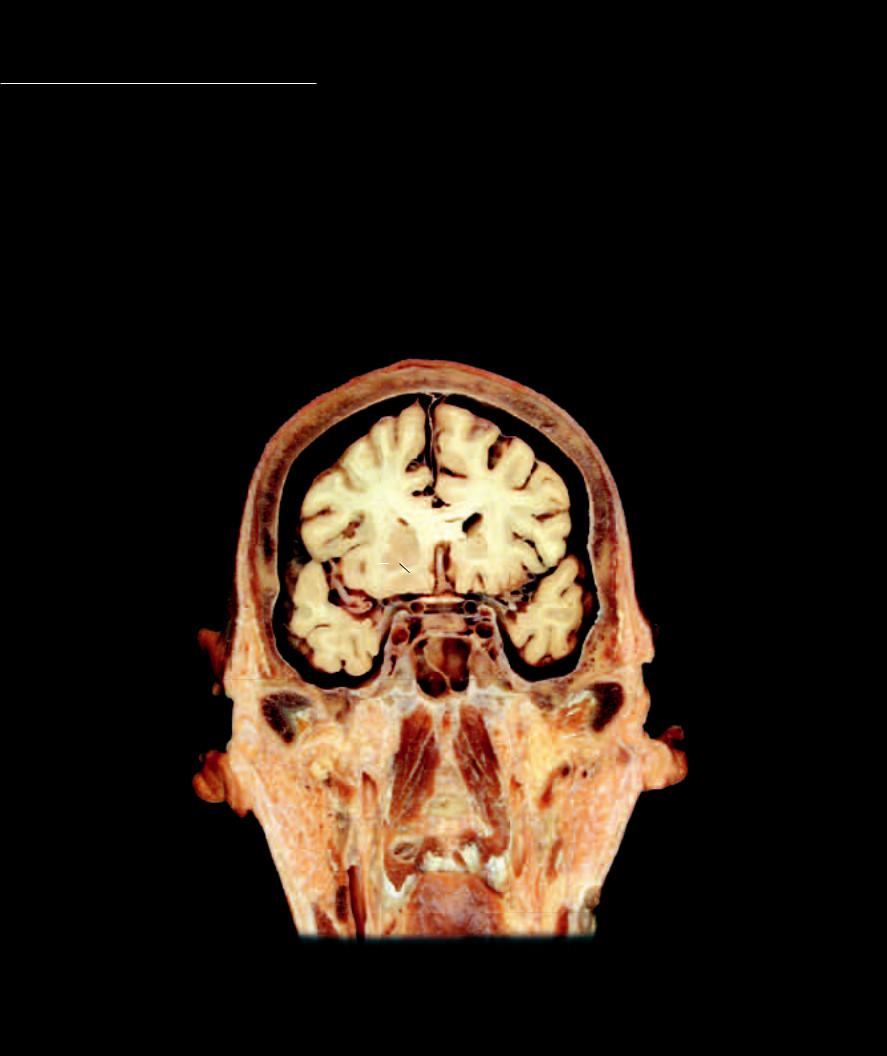
The brain sections on this and the following page depict aspects of brain anatomy that are not evident on the external views of the brain, and the association of the brain with surrounding structures of the head. Each section is approximately 2
centimeters thick and is an anterior view of three sections in succession. The fi rst section begins at the anterior aspect of the ear and the last section is just posterior to the ear.
1 |
Frontal lobe |
14 |
Flocculus |
27 |
Globus pallidus |
40 |
Sigmoid sinus |
2 |
Parietal lobe |
15 |
Superior vermis |
28 |
Medial thalamic nucleus |
41 |
Internal jugular vein |
3 |
Temporal lobe |
16 |
Superior cerebellar peduncle |
29 |
Lateral thalamic nucleus |
42 |
Tympanic cavity |
4 |
Insular lobe |
17 |
Cerebral peduncle |
30 |
Dentate gyrus |
43 |
Cochlea |
5 |
Lateral ventricle |
18 |
Pituitary gland |
31 |
Circular gyrus |
44 |
Sphenoid sinus |
6 |
Third ventricle |
19 |
Pons |
32 |
Optic chiasm |
45 |
Mastoid air cells |
7 |
Cerebral aqueduct |
20 |
Olive |
33 |
Facial nerve |
46 |
Mandibular condyle |
8 |
Fourth ventricle |
21 |
Corpus callosum |
34 |
Vestibulocochlear nerve |
47 |
Occipital condyle |
9 |
Septum pellucidum |
22 |
Caudate nucleus |
35 |
Vertebral artery |
48 |
Atlas |
10 |
Falx cerebri |
23 |
Internal capsule |
36 |
Middle cerebral artery |
49 |
Axis |
11 |
Tentorium cerebelli |
24 |
Putamen |
37 |
Internal carotid artery |
50 |
Lateral pterygoid muscle |
12 |
Anterior lobe of cerebellum |
25 |
External capsule |
38 |
Anterior cerebral artery |
51 |
Medial pterygoid muscle |
13 |
Posterior lobe of cerebellum |
26 |
Body of fornix |
39 |
Superior sagittal sinus |
52 |
Sternocleidomastoid muscle |
 10
10
1 |
|
|
|
|
25 |
5 |
|
|
22 |
||
|
|
|
|
24 |
|
|
38 |
|
|
||
|
|
|
23 |
36 |
|
|
32 |
|
|
|
37 |
3 |
18 |
|
|
|
37 |
|
44 |
46
50
51
Frontal section of head at anterior aspect of auricle
Anterior view
242
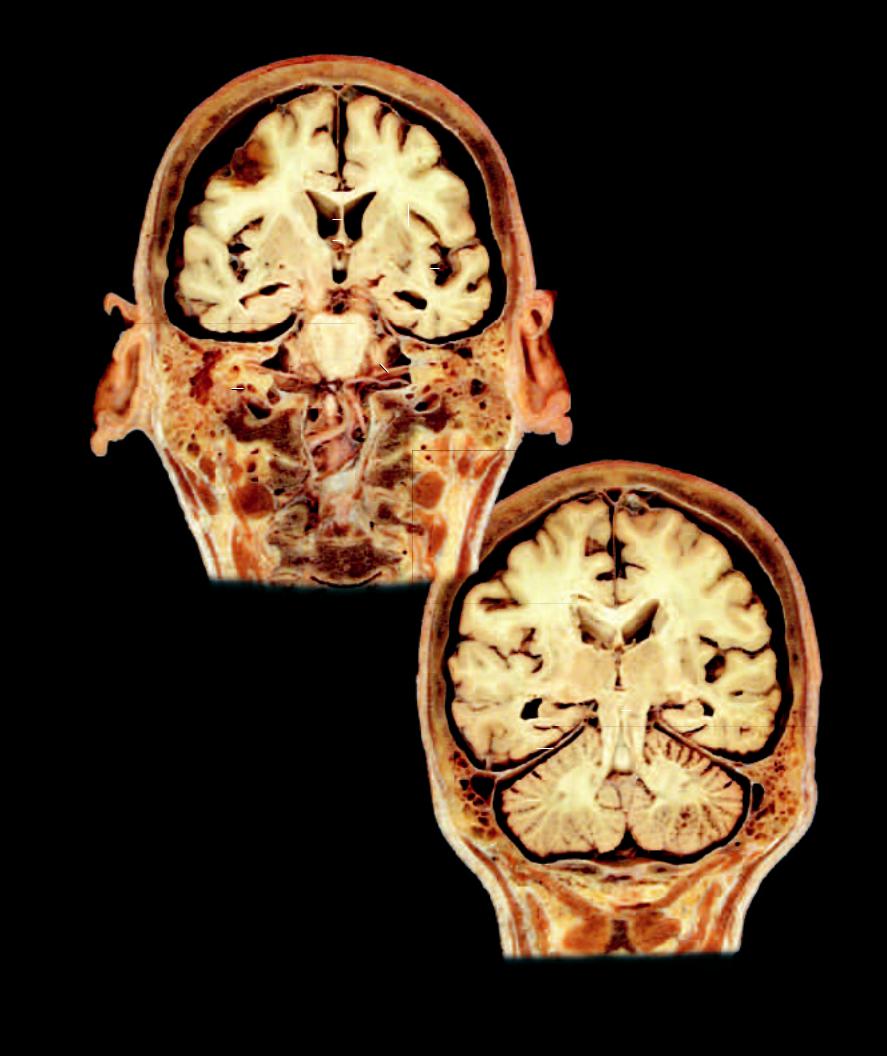
 10
10
2 |
21 |
25 |
|||
|
9 |
|
|
22 |
|
|
|
|
5 |
|
|
|
|
|
|
||
|
|
|
|
|
|
4 |
26 |
|
|
24 |
|
|
|
||||
|
|
|
|
27 |
|
3 |
6 |
36 |
|||
|
|
||||
|
|
|
|
17 |
|
|
19 |
|
|
||
14 |
|
|
|
33 |
|
 34
34
42 43
41 20
35 47
48
39
52
49
 10
10
2
Frontal section of head through middle of auricle
Anterior view
31 |
|
21 |
|
|
|
|
5 |
|
|||
|
4 |
|
|||
|
|
|
|
|
|
|
|
28 |
29 |
||
|
|
6 |
|
|
|
3 |
|
|
|
|
|
5 |
30 |
|
|
7 |
|
|
|
||||
11 |
|
16 |
|
|
|
|
|
|
|
||
|
|
|
|
|
|
|
|
8 |
|
12 |
|
|
|
|
|
|
|
40 |
|
15 |
|
|
|
45
13
52
Frontal section of head just postrior to auricle
Anterior view
243
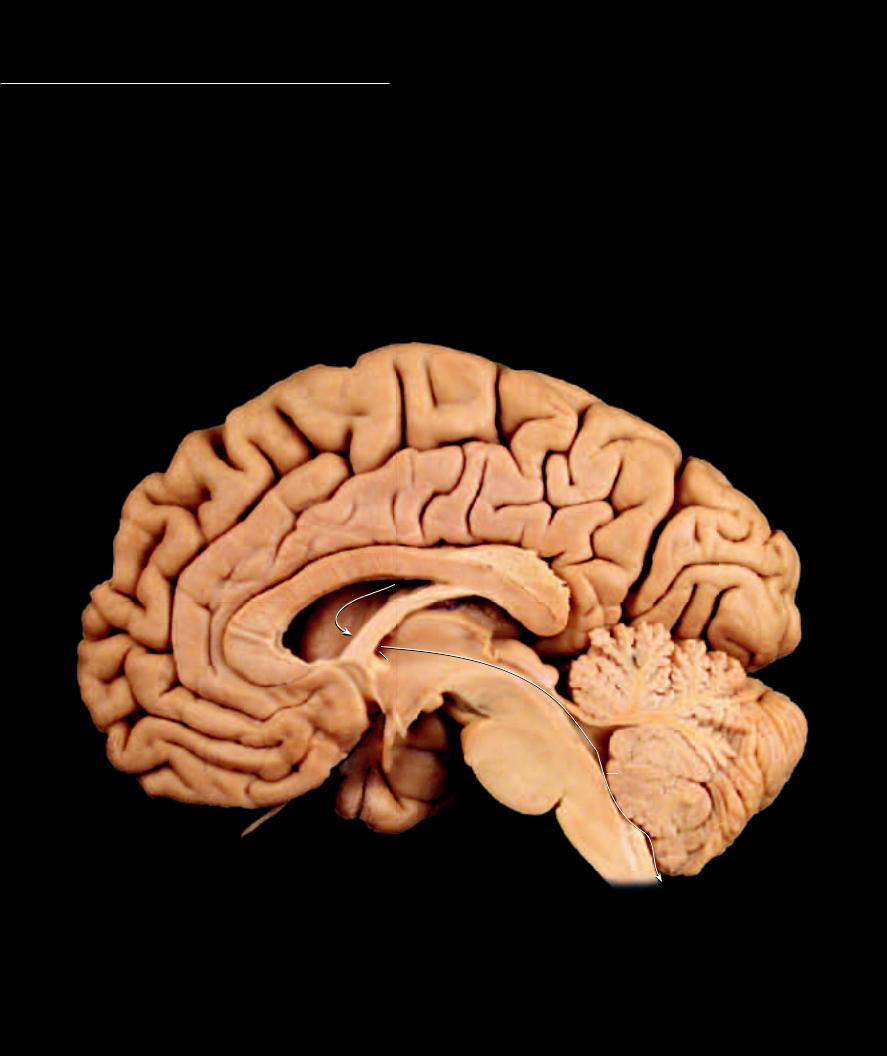
Developmentally the entire central nervous system forms from the hollow neural tube. As development proceeds and the wall of the neural tube becomes increasingly thicker, the hollow lumen of the tube
undergoes changes in relative size and shape throughout different regions of the changing central nervous system. As a result of this developmental history, there remains a hollow interconnected center throughout the entire central nervous system. This hollow core forms the ventricular system. Beginning within the cerebral hemispheres are the large paired lateral ventricles. Each lateral ventricle has a C-shape like its corresponding hemisphere. The lateral ventricles communicate via the interventricular foramina with a midline cavity, the third ventricle. The third ventricle sits within the core of the diencephalon where the right and left thalamus form its lateral walls. From the third ventricle a narrow channel, the aqueduct of the midbrain or cerebral aqueduct, passes through the core of the midbrain. This narrow channel expands in the region of the pons and cerebellum to form the fourth ventricle. The fourth ventricle tapers through the medulla to enter the spinal cord as the central canal. Within the four ventricles of the brain convoluted aggregations of capillaries, called a choroid plexus, project into the cavity of the ventricle. These capillary projections are the principal site for the production of cerebrospinal fluid.
13
16 |
|
8 |
|
14 |
|
|
|
1 |
|
|
|
11 |
|
19 |
|
9 |
|
|
|
|
|
18 |
|
|
|
1 |
|
|
|
|
|
|
|
|
12 |
|
|
3 |
21 |
|
2 |
4 |
||
|
|
|||
|
|
|
||
|
|
|
|
22 |
20
17
25
|
|
5 |
|
|
15 |
23 |
|
|
6 |
|
|
|
||
|
|
24 |
|
|
|
|
|
|
Sagittal section of braining revealing the ventricular system
Medial view, arrows show path of cerebrospinal fluid
244
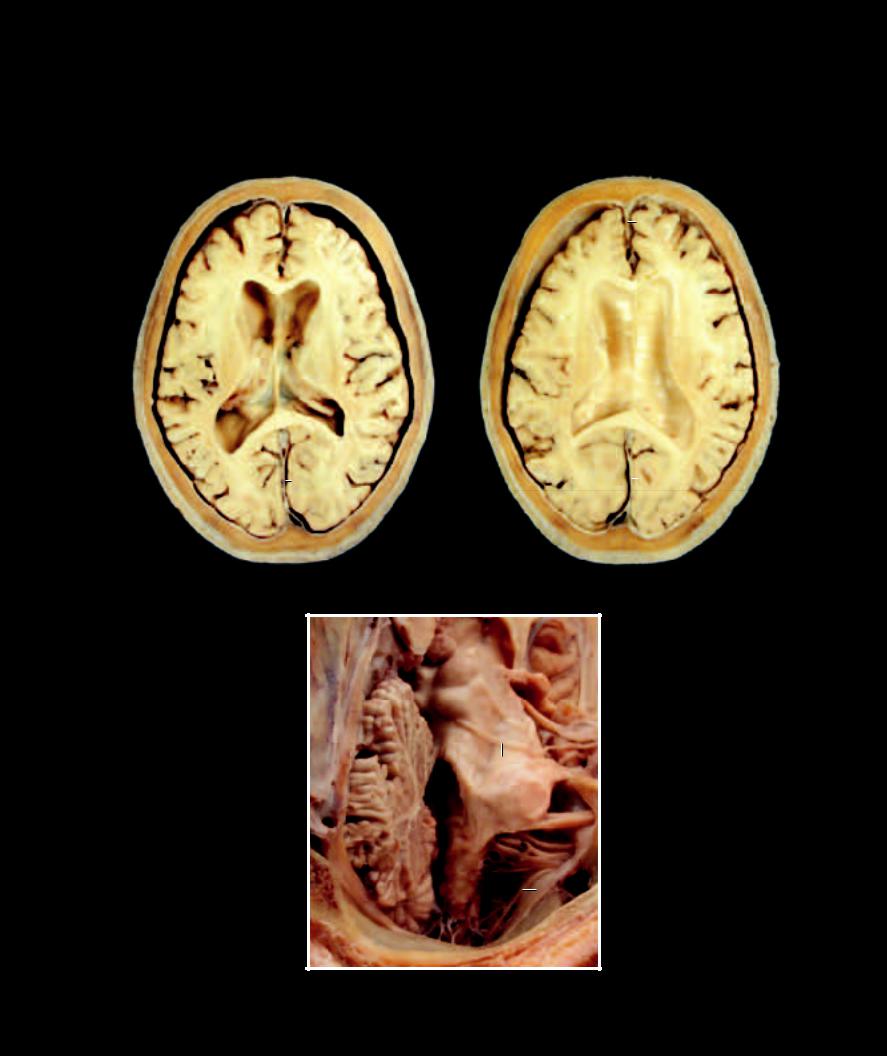
1 |
Lateral ventricle |
9 |
Caudate nucleus |
17 |
Hypothalamus |
25 |
Cerebellum |
2 |
Interventricular foramen |
10 |
Septum pellucidum |
18 |
Thalamus |
26 |
Falx cerebri |
3 |
Third ventricle |
11 |
Fornix |
19 |
Pineal gland |
27 |
Internal carotid artery |
4 |
Cerebral aqueduct |
12 |
Frontal lobe |
20 |
Midbrain |
28 |
Middle cerebellar peduncle |
5 |
Fourth ventricle |
13 |
Parietal lobe |
21 |
Superior colliculus |
29 |
Trochlear nerve |
6 |
Median aperture |
14 |
Occipital lobe |
22 |
Inferior colliculus |
30 |
Vestibulocochlear nerve |
7 |
Choroid plexus |
15 |
Temporal lobe |
23 |
Pons |
31 |
Vagus nerve |
8 |
Corpus callosum |
16 |
Cingulate gyrus |
24 |
Medulla oblongata |
32 |
Accessory nerve |
26
12 |
12 |
|
1
9
8
10
7 |
13 |
13 1
26 |
|
26 |
|
14
14
Floor of lateral ventricles |
Roof of lateral ventricles |
Superior view |
Inferior view |
19
21 20
22
27
|
29 |
5 |
28 |
|
25
30
31
24
32
Fourth ventricle
Posterolateral view
245
